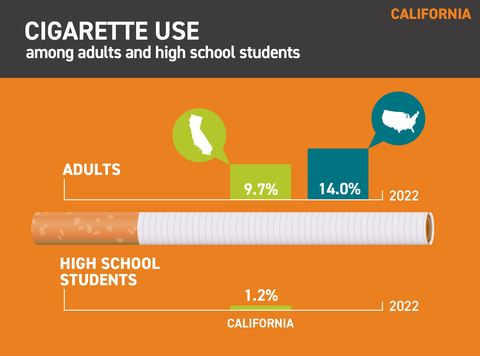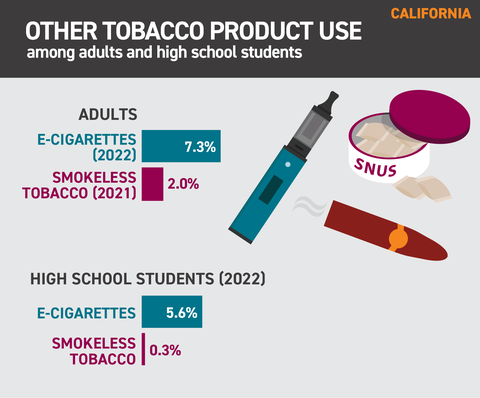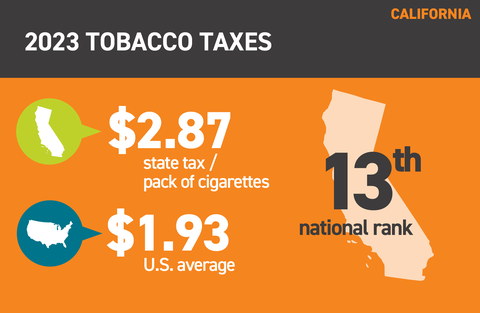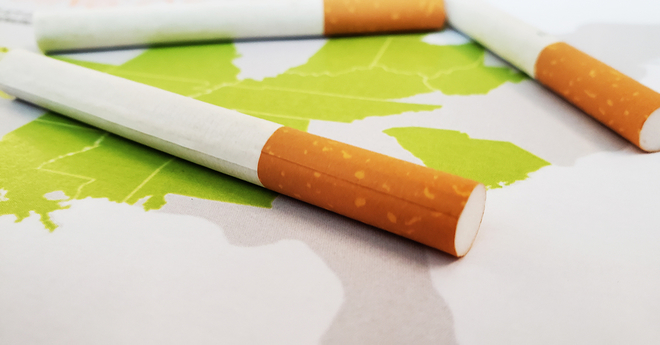Tobacco use in California 2023
Cigarette use: California*
Smoking rate in California
- In 2022, 9.7% of adults in California smoked. Nationally, adult smoking prevalence was 14.0%.1
- In 2022, 1.2% of high school students in California smoked cigarettes on at least one day in the past 30 days.2 Nationally, smoking prevalence among high school students was 3.8%.2
Other tobacco product use: California
Vaping rate in California
- In 2022, 7.3% of adults in California used e-cigarettes.1
- In 2021, 2.0% of adults in California used smokeless tobacco every day or some days.3
- In 2022, 5.6% of high school students in California used electronic vapor products on at least one day in the past 30 days.2
- In 2022, 0.3% of high school students in California used chewing tobacco, snuff or dip on at least one day in the past 30 days.2
Economics of tobacco use and tobacco control
Tobacco taxes in California
- California received $2.7 billion (estimated) in revenue from tobacco settlement payments and taxes in fiscal year 2022.5
- Of this, the state allocated $199.5 million in state funds to tobacco prevention in fiscal year 2022, 57.3% of the Centers for Disease Control and Prevention’s annual spending target.5
- Smoking-related health care costs: $15.44 billion per year.5
- Smoking-related losses in productivity: $28.1 billion per year.6
California tobacco laws
California tobacco laws
Tobacco taxes
- California is ranked 13th in the U.S. for its cigarette tax of $2.87 per pack (enacted April 2017), compared with the national average of $1.93. (New York has the highest tax at $5.35 and Missouri has the lowest at 17 cents.)7-9
- E-cigarettes have an excise tax of 12.5% (as of July 1, 2022).10
- All other tobacco products are taxed at 62.78% of the wholesale price.7,8
Clean indoor air ordinances
- Smoking is prohibited in all government and private workplaces, public schools, restaurants, bars, casinos/gaming establishments (tribal establishments exempt), retail stores, recreational/cultural facilities and childcare facilities.8
- E-cigarettes are included in the state’s clean indoor air law.11
Flavor restrictions
- The sale of flavored tobacco products, except loose leaf tobacco, hookah, and premium cigars, is prohibited.12
Licensing laws
- Retailers, wholesalers, and distributors are required to obtain a license to sell tobacco products.7
- Retailers, wholesalers, and distributors are required to obtain a license to sell e-cigarette products.11
Youth access laws
- In December 2019, the United States adopted a law raising the federal minimum age of sale of all tobacco products to 21, effective immediately.
- Establishments are required to post signs stating that sales to minors are prohibited.7
- A tobacco retailer, or any of the retailer's agents or employees, shall not sell, offer for sale, or possess with the intent to sell or offer for sale, a flavored tobacco product or a tobacco product flavor enhancer.7
Baseball stadium laws
- The use of smokeless tobacco is prohibited in California’s five professional baseball stadiums.7
Local tobacco laws
- Beverly Hills prohibits the sale of all tobacco products in the city; cigar lounges are exempt and guests in the city’s luxury hotels can acquire cigarettes through their concierge or room service. Manhattan Beach prohibits the sale of all tobacco products in the city.12
- 41 localities have banned the sale of all e-cigarettes, with variances for those products that have received FDA premarket approval.12
- 48 cities and counties have banned pharmacies from selling tobacco products, including Alameda County, Contra Costa County, Los Angeles County, Marin County, Pacifica, San Francisco, San Mateo County, Santa Clara County, and Sonoma County.13
- San Francisco caps the number of tobacco sales permits in each of the city’s 11 districts at 45, and new tobacco retailers are prohibited within 500 feet of any school or another retailer.14
Quitting statistics and benefits
Quitting smoking in California
- The CDC estimates 52.8% of daily adult smokers in California quit smoking for one or more days in 2019.3
- In 2014, the Affordable Care Act required that Medicaid programs cover all quit medications.8**
- California’s state quit line invests $3.23. per smoker, compared with the national median of $2.37.8
- California does not have a private insurance mandate provision for quitting tobacco.8
Notes and references
Notes and references
Updated June 2023
* The datasets for both adults and youth prevalence were used to make direct comparisons at the state and national levels. National prevalence reported here may differ from what is reported in our national-level fact sheets. The numbers here also reflect the most recent data available. Dates of available data may differ across state fact sheets.
**The seven recommended quitting medications are NRT gum, NRT patch, NRT nasal spray, NRT inhaler, NRT lozenge, Varenicline (Chantix) and Bupropion (Zyban).
Fiore MC, et al. Treating Tobacco Use and Dependence: 2008 Update. Clinical Practice Guideline. Rockville, MD: US Department of Health and Human Services. Public Health Service: May 2008.
1. CDC, Behavioral Risk Factor Surveillance System, 2022.
2. RTI International, Results of the 2022 California Youth Tobacco Survey, 2023.
3. CDC, Behavioral Risk Factor Surveillance System, State Tobacco Activities Tracking and Evaluation System, 2021.
4. CDC, Youth Risk Behavioral Surveillance System, 2021.
5. Campaign for Tobacco-Free Kids, Broken Promises to Our Children: a State-by-State Look at the 1998 State Tobacco Settlement 24 Years Later FY2023, 2023.
6. Campaign for Tobacco-Free Kids, Toll of Tobacco in the United States.
7. American Lung Association, State Legislated Actions on Tobacco Issues (SLATI).
8. American Lung Association, State of Tobacco Control, 2023.
9. Campaign for Tobacco-Free Kids. State Cigarette Excise Tax Rates & Rankings. https://www.tobaccofreekids.org/assets/factsheets/0097.pdf. Accessed October 4th 2023.
10. California Legislature. SB-395 Excise tax: electronic cigarettes: Health Careers Opportunity Grant Program: Small and Rural Hospital Relief Program. https://leginfo.legislature.ca.gov/faces/billNavClient.xhtml?bill_id=202120220SB395. Published 2021. Accessed October 4th 2023.
11. Public Health Law Center. U.S. E-Cigarette Regulation: 50-State Review. http://www.publichealthlawcenter.org/resources/us-e-cigarette-regulations-50-state-review. Accessed October 4th 2023.
12. Truth Initiative, Local restrictions on flavored tobacco and e-cigarette products. https://truthinitiative.org/research-resources/emerging-tobacco-products/local-restrictions-flavored-tobacco-and-e-cigarette. Accessed October 4th 2023.
13. Americans Nonsmokers' Rights Foundation. Municipalities with Tobacco-Free Pharmacy Laws. http://no-smoke.org/pdf/pharmacies.pdf. Accessed October 4th 2023.
14. San Francisco Board of Supervisors. San Francisco Health Code Article 19H. http://www.sfbos.org/ftp/uploadedfiles/bdsupvrs/ordinances14/o0259-14.pdf. Published 2014. Accessed October 4th 2023.




